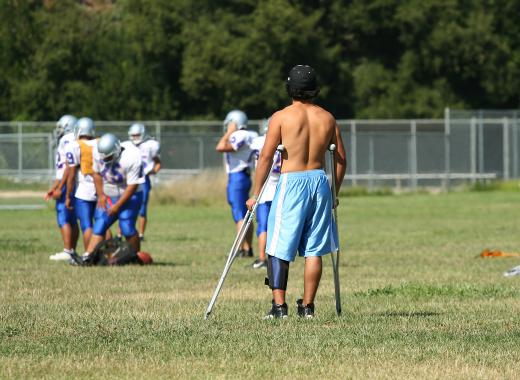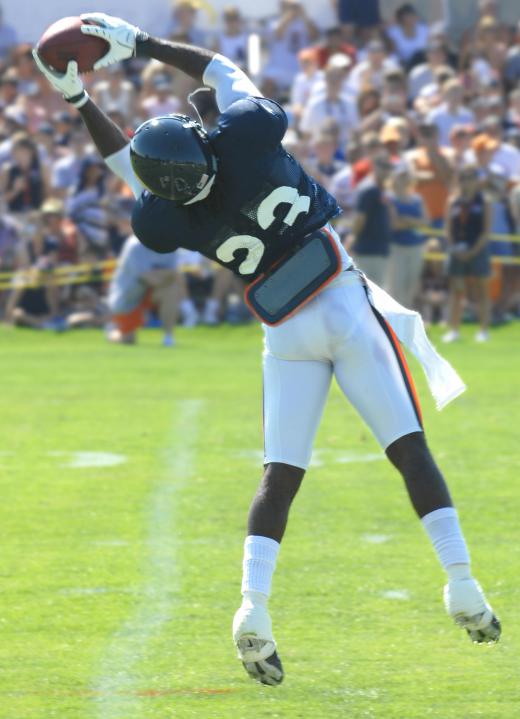At Sports&Hobbies, we're committed to delivering accurate, trustworthy information. Our expert-authored content is rigorously fact-checked and sourced from credible authorities. Discover how we uphold the highest standards in providing you with reliable knowledge.
In Football, what is Injured Reserve?
In the National Football League (NFL), the premier professional league for American football, a player who has suffered an injury that is significant enough to cause him to miss one or more games might be placed on the injured reserve (IR) list by his team. Any player who is on injured reserve remains under contract with the team but cannot practice or play in that team's games for the rest of that season. A player on IR also does not count against the team's 53-man roster limit, so the team is able to sign another player as a replacement. As of June 2012, the NFL was in the process of revising its rules to allow one player per team to be placed on IR and still be eligible to play in games later that season, under certain circumstances, but the rule change had not been finalized.
Roster Rules

The NFL limits the number of players a team can have on its roster. During the season, the limit is 53 players. Only 46 of those players can be on the active list for a game, and the seven inactive players cannot play that day. In some cases, a player who has had an injury will simply be made inactive for games until he is healthy enough to play again.

When a player's injury is significant enough to keep him out of one or more games, the team has the option of placing him on injured reserve and signing another player to its 53-man roster. This will allow the team to activate the replacement player, if needed. If the player has a long-term injury, he almost always will be placed on IR. When the player might be healthy enough to play after a few games or before the end of the season — or when the team isn't sure how long it will take for the player to recover — the team must consider all of the possibilities and make a decision about whether to place the player on injured reserve.
Injured Players' Status and Salaries

Players usually do not like to be placed on injured reserve. For many players, the main reason for this is because it prevents them from playing for the rest of the season. Some players might believe that they could play again that season after recovering from their injuries, but being placed on injured reserve makes that impossible. A player cannot refuse to go on IR, because the team controls his status within the league as long as it continues to pay him according to his contract.
Many players also make less money if they are put on the IR list, which is sometimes referred to as the reserve/injured list. Players often agree to contracts that include reduced salaries if they go on IR. Often called split salaries, they usually are between 40 percent and 70 percent of the players' normal salaries. Not all contracts include reduced salaries for players who are put on IR. The Collective Bargaining Agreement between the NFL and the NFL Players Association (NFLPA) also sets minimum amounts for players' split salaries.
Injury Settlements
When a player has an injury that normally would not keep him out of action for the rest of the season, the team also might agree to an injury settlement with him and release him instead of placing him on injured reserve. An injury settlement usually is an amount of money equal to what the player would receive in salary during the time when he is recovering from his injury. Being released allows the player to sign a contract with another team and, when he is healthy again, play in games that season. For example, a player who has a sprained ankle that would prevent him from playing for four weeks might agree to an injury settlement of four weeks' salary instead of being placed on IR for the rest of the season. He could then sign with a new team and play after he has recovered.
Proposed Rule Change
In 2012, the NFL proposed a rule change that would allow one player per team to be placed on injured reserve temporarily instead of for the rest of the season. The player would have to have been on the team's roster during the first week of the regular season to qualify for this exception. He would not be allowed to practice or play for the first six weeks after being put on IR and would have to miss at least eight games before being allowed to play again. This rule needed to be approved by the NFLPA before it could go into effect.
Other Lists
The NFL also has other designations for players who are injured and cannot play. The Physically Unable to Perform (PUP) list is for players who were injured during a previous season and have not fully recovered. If a player suffers an injury doing something other than playing, practicing and training with his team, he might be placed on the Non-Football Injury (NFI) list.
Like a player on IR, a player on either of these lists does not count against his team's roster limit. He might receive a reduced salary, if it is allowed by his contract, or he might not be paid at all if he suffered a non-football injury. The PUP and NFI lists also have their own rules regarding things such as who is eligible to be placed on the lists, what players can do while on these lists, how long they can be on the lists and the circumstances in which the players are allowed to begin practicing and playing again.
AS FEATURED ON:
AS FEATURED ON:













Discussion Comments
I have recently seen the term reserved/injured instead of injured reserve. Is there a difference? --Sparky
@ Amphibious54- The PUP is the Physically Unable to Perform list. The PUP list differs from the IR list in a few important ways. Players must start the preseason on the PUP list. A team cannot put a player on PUP after he has participated in any practice. The player must either remain on the active roster, or be put on injured reserve. If a player begins the season on the PUP list, they are automatically not allowed to play the first six games. If they are to play that season, then they must begin practice by the ninth week or they are designated as PUP for the season.
The PUP list is basically a tool to keep NFL depth charts up to date. As long as a player is PUP they are not taking up space on the active roster.
What is the difference between the PUP list and the Injured reserve list?
The dreaded IR list! When a team puts a star player on injured reserve, it can be devastating for both the player, and his fans. I play fantasy football, and having one of your top draft picks sidelined by injury can be the difference between a winning and losing season.
It's not so bad when you play free fantasy football, but when you pay for prize eligible leagues, you run the risk of losing your money. I lost Ryan Grant from Green Bay this year in the first game of the season. He was my pick in the second round. Now I'm hoping that his replacement Brandon Jackson can fill his shoes.
I think all injured players that are so injured they won't play for the season will be placed on injured reserve. That is, a team who didn't like a guy, can't take advantage of a bad player injuring himself and kick him off the team after being injured. He'll still get that season's salary. But, if that player had a multi-year contract the team isn't bound for the rest of the contract; the team can let the injured player go after finishing off the year in which he was injured.
Post your comments